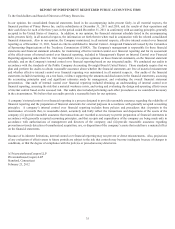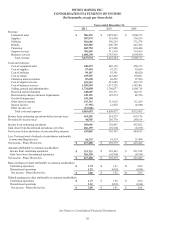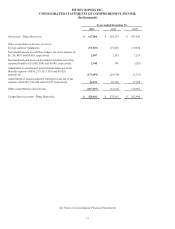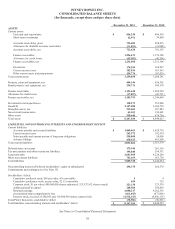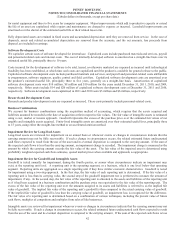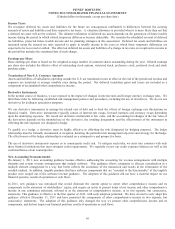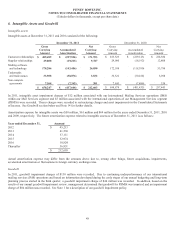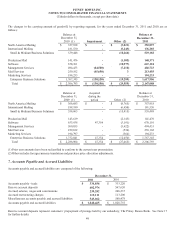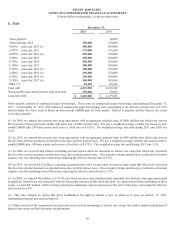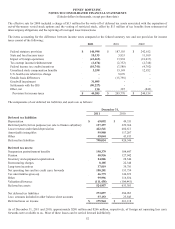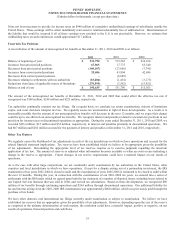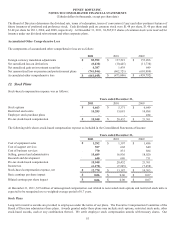Pitney Bowes 2011 Annual Report Download - page 63
Download and view the complete annual report
Please find page 63 of the 2011 Pitney Bowes annual report below. You can navigate through the pages in the report by either clicking on the pages listed below, or by using the keyword search tool below to find specific information within the annual report.PITNEY BOWES INC.
NOTES TO CONSOLIDATED FINANCIAL STATEMENTS
(Tabular dollars in thousands, except per share data)
45
Income Taxes
We recognize deferred tax assets and liabilities for the future tax consequences attributable to differences between the carrying
amounts of assets and liabilities and their respective tax bases. A valuation allowance is provided when it is more likely than not that
a deferred tax asset will not be realized. The ultimate realization of deferred tax assets depends on the generation of future taxable
income during the period in which related temporary differences become deductible. We consider the scheduled reversal of deferred
tax liabilities, projected future taxable income and tax planning strategies in this assessment. Deferred tax assets and liabilities are
measured using the enacted tax rates expected to apply to taxable income in the years in which those temporary differences are
expected to be recovered or settled. The effect on deferred tax assets and liabilities of a change in tax rates is recognized in income in
the period that includes the enactment date of such change.
Earnings per Share
Basic earnings per share is based on the weighted-average number of common shares outstanding during the year. Diluted earnings
per share also includes the dilutive effect of outstanding stock options, restricted stock, preference stock, preferred stock and stock
purchase plans.
Translation of Non-U.S. Currency Amounts
Assets and liabilities of subsidiaries operating outside the U.S. are translated at rates in effect at the end of the period and revenue and
expenses are translated at average monthly rates during the period. Net deferred translation gains and losses are included as a
component of accumulated other comprehensive income.
Derivative Instruments
In the normal course of business, we are exposed to the impact of changes in interest rates and foreign currency exchange rates. We
limit these risks by following established risk management policies and procedures, including the use of derivatives. We do not use
derivatives for trading or speculative purposes.
We use derivative instruments to manage the related cost of debt and to limit the effects of foreign exchange rate fluctuations on
financial results. Derivative instruments typically consist of interest-rate swaps, forward contracts and currency swaps depending
upon the underlying exposure. We record our derivative instruments at fair value, and the accounting for changes in the fair value of
the derivatives depends on the intended use of the derivative, the resulting designation, and the effectiveness of the instrument in
offsetting the risk exposure it is designed to hedge.
To qualify as a hedge, a derivative must be highly effective in offsetting the risk designated for hedging purposes. The hedge
relationship must be formally documented at inception, detailing the particular risk management objective and strategy for the hedge.
The effectiveness of the hedge relationship is evaluated on a retrospective and prospective basis.
The use of derivative instruments exposes us to counterparty credit risk. To mitigate such risks, we enter into contracts with only
those financial institutions that meet stringent credit requirements. We regularly review our credit exposure balances as well as the
creditworthiness of our counterparties.
New Accounting Pronouncements
On January 1, 2011, new accounting guidance became effective addressing the accounting for revenue arrangements with multiple
elements and certain revenue arrangements that include software. This guidance allows companies to allocate consideration in a
multiple element arrangement in a way that better reflects the economics of the transaction and results in the elimination of the
residual method. In addition, tangible products that have software components that are “essential to the functionality” of the tangible
product were scoped out of the software revenue guidance. The adoption of this guidance did not have a material impact on our
financial position, results of operations or cash flows.
In 2011, new guidance was introduced that would eliminate the current option to report other comprehensive income and its
components in the statement of stockholders’ equity, and require an entity to present items of net income and other comprehensive
income in one continuous statement, referred to as the statement of comprehensive income, or in two separate, but consecutive,
statements. This guidance is effective in the first quarter of 2012, with early adoption permitted. We have elected to early adopt this
guidance effective December 31, 2011 and have presented the components of other comprehensive income in two separate, but
consecutive, statements. The adoption of this guidance only changed the way we present other comprehensive income and its
components, and did not impact our financial position, results of operations or cash flows.


